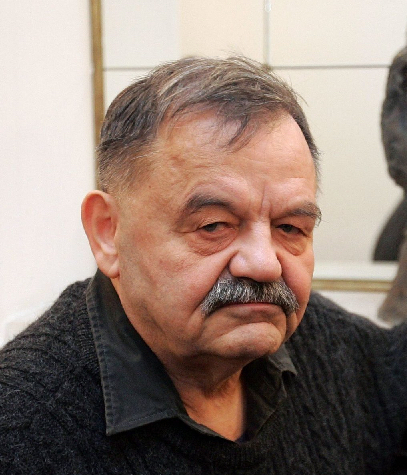
Alfred Hrdlicka
Alfred Hrdlicka is a visual artist, who originates from Austria, like other well-known artists such as Constain Luser, Brigitte Kowanz, Eva Grubinger. The artist was born in 27 February 1928 in Vienna and passed away on 5 December 2009.
Alfred Hrdlicka was an important Austrian sculptor, draughtsman, painter, and writer. He is considered a political artist, many of his works being memorials warning against war and fascism. The material he preferred for his sculptures was stone.
Hrdlicka’s youth was marked by the political turbulences of the interwar period and the regime of National Socialism. Through his father, a Communist trade union functionary, Hrdlicka became aware of political problems at an early age. The focus of his work is on the traumatised people of the post-war years, with pain and sorrow inscribed in his expressive figures.
Between 1946 and 1957, Alfred Hrdlicka studied painting under Josef Dobrowsky and Albert Paris Gütersloh and sculpture under Fritz Wotruba at the Vienna Academy of Fine Arts. In 1964, when Hrdlicka represented Austria together with Herbert Boeckl at the 32nd Venice Biennale, he achieved international renown.
Throughout his life, Hrdlicka was committed to the fight against war, violence, and fascism. His most important work, the Monument of Admonishment against War and Fascism, stirred fervent controversy when it was installed on Albertinaplatz (Vienna, 1983/88).
In addition to his sculptures, Hrdlicka also produced series of paintings, drawings, and etchings, such as the Plötzensee Dance of the Dead and works dealing with the French Revolution, the peasants’ revolts or the Revolutions of 1848. Moreover, he designed numerous stage sets.
Alfred Hrdlicka held several professorships. For example, between 1973 and 1975 he was a professor at the Hamburg Art Academy and between 1986 and 1989 had a chair in sculpture at the Berlin University of the Arts. In 1989 he was called to the University of Applied Arts in Vienna. His teaching method was quite controversial, as he turned his back on abstract art, which he felt was “bloodless”.
As Oskar Lafontaine put it in his preface to Alfred Hrdlicka, Zeichnungen, a volume published in 1994, Hrdlicka’s work was guided by “a ruthless humanism that also displayed murder, terror, and sexual brutality with sometimes shocking clarity.” For him, art was first and foremost a means of political agitation and a mouthpiece of the oppressed and politically and socially persecuted.
Regarding the historical context in Austria that influenced the artist, at the start of the 20th century, Austria was among the most innovative and culturally progressive countries. It fostered key developments in the Arts and Crafts Movement and Art Nouveau, called Jugendstil in German, from around 1895 to 1910, forming an important bridge between the 19th century and the onset of modernism. This kind of progressive, avant-garde thinking led directly into the Viennese Secession movement, one of the key art and design movements of the early twentieth century. It was formed in 1897 by a group of Austrian painters, graphic artists, sculptors and architects, including Josef Hoffman, Koloman Moser, Otto Wagner, and Gustave Klimt, when artists resigned, en masse, from the Association of Austrian Artists in protest against its support for more traditional artistic styles. and an exchange of ideas with artists outside Austria, disputing artistic nationalism, renewing the decorative arts and, most crucially, creating a "total art (Gesamtkunstwerk)" that unified painting, architecture, and the decorative arts. The group was fervently opposed to the dominance of the official Vienna Academy of the Arts (the Vienna Künstlerhaus), and official art salons, with their traditional orientation toward Historicism. Ultimately the group broke apart, the decorative artists choosing instead to focus on a new guild called the Wiener Werkstatte. In the late 1930s, Austria was annexed by the rising force of Hitler's Nazi Germany, an act known as the Anschluss, and which organised Austria into a province of a greater German Reich. During this period, like in Germany, the Avant-garde was labelled „Entartete Kunst“, translating to „degenerate art“, and was oppressed with only 'official' social realist art being approved, or even allowed by the state. Consequently, there was a significant exodus of creative talent who decided that their interests would be best served by relocating to London or New York. In the 20th century, key Austrian artists included Josef Hoffman, Gustav Klimt, Egon Schiele, Herbert Bayer (the typography and graphic design pioneer of the Bauhaus), architect and designer Josef Frank, Oskar Kokoschka, Alfred Kubin, Friedensreich Hundertwasser, Maria Lassnig, Hermann Nitsch, Arnulf Rainer, Franz West and Erwin Wurm.
EXHIBITIONS:
2008 Sculptures, Albertinaplatz, Vienna
Alfred Hrdlicka - Fleischeslust, Galerie Ernst Hilger, Vienna
2007 Homenaje a Picasso, National Museum of Beellas Artes, Santiago
2006 Favorites from the Worbes Collection, Kunstammlungen zu Weimar - Neues Museum, Weimar
Alfred Hrdlicka - Music Monster Mozart, Gallery Earnst Hilger, Vienna
2005 STILL, Lentos Kunstmuseum Linz, Linz
2004 Vision of a collection, Museum der Moderne Salzburg, Salzburg
Alfred Hrdlicka - Serail - Sculpture drawings, Gallery Ernst Higler, Vienna
2003 Alfred Hrdlicka - I can't think of anything - I notice something, Gallery Ernst Hilger, Vienna
Figuration, Gallery Hermeyer, Munich
2002 SALON 2002 - in zentrum: diskurs, Kunstlerhaus Wien, Vienna
2001 Images of people. MMK Museum of Modern Art - Stiftung WOrlen, Passau
Alfred Hrdlika - "Wars of Faith" - Works on paper, graphic/bronze sculptures, Gallery Barbara von Stechow, Frankfurt/Main
2000 ALFRED HRDLICKA - Nibelungentreue, Galerie Ernst Hilger, Vienna




